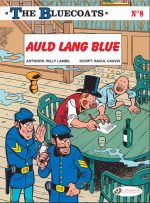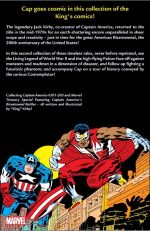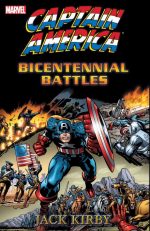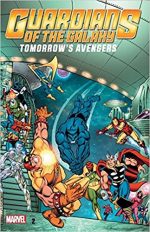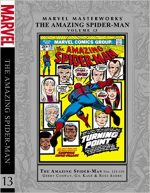
By Stan Lee, Jack Kirby & various (Marvel)
ISBN: 978-1-3029-0435-7
Fantastic Four #1 (bi-monthly and cover-dated November 1961, by Stan Lee, Jack Kirby, George Klein & Christopher Rule was crude: rough, passionate and uncontrolled excitement. Thrill-hungry kids pounced on it and the raw storytelling caught a wave of change starting to build in America. It and succeeding issues changed comicbooks forever.
This full-colour compendium – also available as a digital download – collects Fantastic Four #19-32 plus the first two giant-sized Annuals issues of progressive landmarks (spanning July 1963 to October 1963) and tellingly reveals how Stan & Jack cannily built on that early energy to consolidate the FF as the leading title and most innovative series of the era.
As seen in the ground-breaking premier issue, maverick scientist Reed Richards, his fiancé Sue Storm, their close friend Ben Grimm and Sue’s teenaged brother survived an ill-starred private space-shot after Cosmic rays penetrated their ship’s inadequate shielding and mutated them all.
Richards’ body became elastic, Sue gained the power to turn invisible, Johnny Storm could turn into living flame and tragic Ben devolved into a shambling, rocky freak.
Here the wonderment resumes with the contents of the first summer Annual: a spectacular 37-page epic battle as, finally reunited with their wandering prince, the warriors of Atlantis invade New York City and the rest of the world in ‘The Sub-Mariner versus the Human Race!’ by Lee, Kirby and inker Dick Ayers.
A monumental tale by the standards of the time, the saga saw the FF repel the undersea invasion through valiant struggle and brilliant strategy as well as providing a secret history of the secretive race Homo Mermanus. Nothing was really settled except a return to the original status quo, but the thrills were intense and unforgettable…
Also included are rousing pin-ups and fact file features ‘A Gallery of the Fantastic Four’s Most Famous Foes!’, ‘Questions and Answers about the Fantastic Four’, a diagrammatic trip ‘Inside the Baxter Building’ and a charming short tale ‘The Fabulous Fantastic Four meet Spider-Man!’.
This is an extended re-interpretation of the first meeting between the two most popular Marvel brands from the premiere issue of the wallcrawler’s own comic. Pencilled this time by Kirby, the dramatic duel benefitted from Steve Ditko’s inking which created a truly novel look.
Cover-dated October 1963, Fantastic Four #19 introduced another of the company’s top-ranking super-villains as the quarrelsome quartet travelled back to ancient Egypt and ‘Prisoners of the Pharaoh!’ This time travel tale has been revisited by so many writers that it is considered one of the key stories in Marvel history introducing a future-Earth tyrant who would evolve into overarching menace Kang the Conqueror.
Another universe-threatening foe was introduced and defeated by brains not brawn in
FF#20 as ‘The Mysterious Molecule Man!’ menaced New York before being soundly outsmarted, whilst the next issue guest-starred Nick Fury: lead character in Marvel’s only war comic.
Sgt. Fury and his Howling Commandos was another solid hit, but eventually the brusque and brutal star would metamorphose into the company’s answer to James Bond. Here, however, he’s a simple CIA agent seeking the team’s aid against a sinister demagogue called ‘The Hate-Monger’ in a cracking yarn with a strong message, inked by comics veteran George Roussos, under the protective nom-de-plume George Bell.
By this juncture the team were firmly established and creators Lee & Kirby were well on the way to toppling DC/National Comics from their decades-held top spot through an engaging blend of brash, folksy and consciously contemporaneous sagas, mixing high concept, low comedy, trenchant melodrama and breathtaking action.
Unseen since the premiere issue, #22 finally saw ‘The Return of the Mole Man!’; another full-on monster-mashing fight-fest, chiefly notable for the debut of the Invisible Girl’s newly developed powers of projecting force fields and “invisible energy†– which would eventually make her one of the mightiest characters in the company’s pantheon.
Fantastic Four #23 heralded ‘The Master Plan of Doctor Doom!’, which introduced his frankly mediocre minions the Terrible Trio of Bull Brogin, Handsome Harry and Yogi Dakor, although the uncanny menace of “the Solar Wave†was enough to raise the hackles on my 5-year-old neck…
(Do I need to qualify that with: all of me was five but only my neck had properly developed hackles back then?)
Issue #24’s ‘The Infant Terrible!’ was a sterling yarn of inadvertent extra-galactic menace and misplaced innocence, followed by a two-part epic that truly defined the inherent difference between Lee and Kirby’s work and everybody else’s at that time.
Fantastic Four #25 and 26 featured a cataclysmic clash that had young heads spinning in 1964 and led directly to the Emerald Behemoth finally regaining a strip of his own. In ‘The Hulk Vs The Thing’ and ‘The Avengers Take Over!’, a fast-paced, all-out Battle Royale resulted when the disgruntled man-monster came to New York in search of side-kick Rick Jones, and only an injury-wracked FF stood in the way of his destructive rampage.
A definitive moment in the character development of The Thing, the action was ramped up when a rather stiff-necked and officious Avengers team horn in claiming jurisdictional rights on “Bob†Banner (this tale is plagued with pesky continuity errors which would haunt Stan Lee for decades) and his Jaded alter ego. Notwithstanding the bloopers, this is one of Marvel’s key moments and still a visceral, vital read.
The creators had hit on a winning formula by including their other stars in guest-shots – especially as readers could never anticipate if they would fight with or beside the home team. ‘The Search for Sub-Mariner!’ again found the undersea anti-hero in amorous mood, and when he abducted Sue Storm the boys called in Doctor Strange, Master of the Mystic Arts to aid them. Issue #28 is a superb team-up tale too, most notable (for me and many other older fans) for the man who replaced George Roussos.
‘We Have to Fight the X-Men!’ finds the disparate teams battling due to the machinations of Puppet Master and the Mad Thinker, but the inclusion of Chic Stone – Kirby’s most simpatico and expressive inker – elevates the art to indescribable levels of quality.
‘It Started on Yancy Street!’ (FF#29) starts low-key and a little silly in the slum where Ben Grimm grew up, but with the reappearance of the Red Ghost and his Super-Apes the action quickly goes Cosmic and results in a blockbusting battle on the Moon, with the following issue introducing evil alchemist ‘The Dreaded Diablo!’ who almost breaks up the team while casually conquering the world from his spooky Transylvanian castle.
Next up is Fantastic Four Annual #2 from 1964; boldly leading with ‘The Fantastic Origin of Doctor Doom!’, tragically detailing how brilliant gypsy boy Victor Von Doom remakes himself into the most deadly villain in creation.
Following a fresh batch of rogues starring in ‘A Gallery of the Fantastic Four’s Most Famous Foes!’ and pin-ups of Johnny, Sue, Ben, Alicia Masters and Reed, the past informs the present as the ultimate villain believes he has achieved ‘The Final Victory of Dr. Doom!’, but has in fact suffered his most ignominious defeat…
The monthly wonderment resumes with #31’s ‘The Mad Menace of the Macabre Mole Man!’ which precariously balances a loopy plan by the subterranean satrap to steal entire streets of New York City with a portentous sub-plot featuring a mysterious man from Sue’s past, as well as renewing the quartet’s somewhat fractious relationship with the Mighty Avengers…
The secret of that mystery man is revealed in the last tale in this titanic tome. ‘Death of a Hero!’ is a powerful tale of tragedy and regret that spans two galaxies, starring the uniquely villainous Invincible Man who is not at all what he seems…
Adding unique value to the proceedings, this epic encounter closes with a house ad for the first FF Annual plus the unused first cover version, many original art pages by Kirby inked by Ayers, Roussos and Stone, an unused pencilled Kirby cover for FF #20 and a quartet of re-mastered Masterworks collection covers drawn by Jack and painted by Dean White.
This is a truly magnificent book to read highlighting the tales that built a comics empire. The verve, imagination and sheer enthusiasm shines through and the wonder is there for you to share. If you’ve never thrilled to these spectacular sagas then this book of marvels is your best and most economical key to another world and time.
© 1963, 1964, 2017 Marvel Characters, Inc. All rights reserved.


